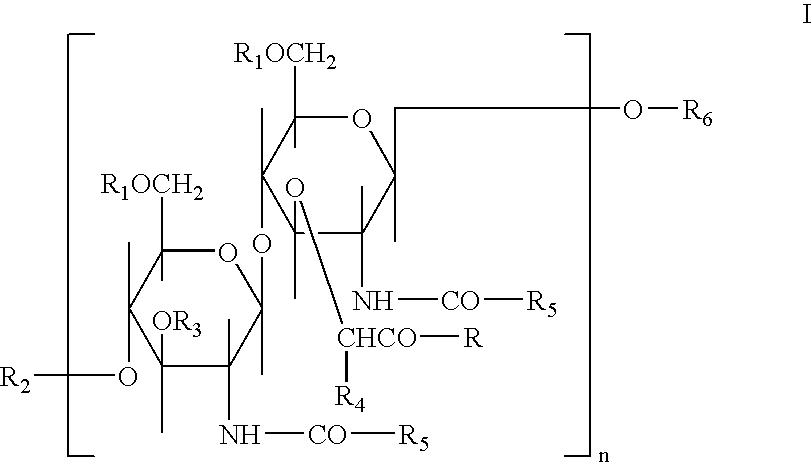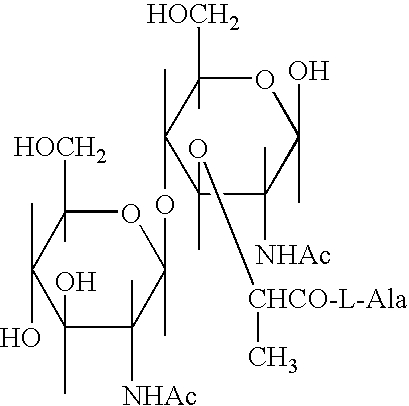Glycopeptides for the treatment of als and other metabolic and autoimmune disorders
a technology of glycopeptides and als, which is applied in the direction of peptide sources, metabolic disorders, extracellular fluid disorders, etc., can solve the problems of ards, stroke, ischemic heart disease, and excessive tnf- production, and achieves improved absorption and bioavailability. , the effect of improving the delivery method
- Summary
- Abstract
- Description
- Claims
- Application Information
AI Technical Summary
Benefits of technology
Problems solved by technology
Method used
Image
Examples
example 1
[0109] A 39 year-old male with bulbar onset ALS in final stage was dependent on pure oxygen to maintain a 94% pulsox and a feeding tube for nutrition. If the patient was removed from pure oxygen to ambient air, a drop in his pulsox to 82% occurred within 3 minutes and respiratory distress occurred. The patient had lost all ability to voluntarily move any muscle group In his body for over 8 months except his eyelids. Patient was fed 400 mg luteolin with 400 mg rutin four times a day via aqueous suspension into his feeding tube and administered 6 mg GMDP as an aqueous oral spray. Within 24 hours of GMDP administration, the patient's pulsox rose to 99%-100% with markedly improved pallor. Upon removal of the oxygen 14 hours after the first GMDP dose, patient was able to maintain a 99% pulsox without any respiratory distress. On day two, an additional 6 mg of GMDP was administered as an aqueous oral spray and the patient's small fingers began to respond to voluntary challenge within 2 ho...
example 2
[0110] A 50 year-old Male with rapidly progressing bulbar onset ALS experiencing upper and lower limb weakness, ataxia, dysphagia, and moderate vocal impairment had been taking 2000 mg luteolin and 2000 mg rutin per day for 7 months was given 10 mg GMDP as an aqueous oral spray. The patient's voice and energy dramatically improved within 40 minutes peaking in improvement at one hour. Intermittent intranasal use of 0.291-1.25 mg of GMDP for one month and subsequent use of GMDP-A for four months as an aqueous intranasal spray 0.9-1.25 mg every 36 to 48 hours dramatically reduced fasciculations, improved the patient's mood, energy, physical strength, swallowing ability, and clarity voice. Patient remains stable after 5 months with no progression in his ALS.
example 3
[0111] A 50 year-old male diagnosed with lower limb onset ALS on Sep. 03, 02 had symptoms of brisk reflexes, moderate muscle atrophy, weakness, fatigue, and fasciculations in both legs including foot drop in the right leg. Due to the patient's weakness and instability in his legs, he was prescribed an AFO brace for his right leg in December of 2001. EMG results showed active denervation in both lower extremities, being quite extensive in the right lower extremity. The patient was unable to walk distances in excess of 15 meters with his AFO. Following his diagnosis with ALS, the patient followed a diet of low carbohydrate intake and high protein intake and began taking 1200-1800 mg of luteolin and 1200-1800 mg of rutin daily. His fasciculations decreased dramatically and his disease slowed in progress. In February of 2003, the patient began therapy with GMDP. He initially took 1.51 mg of GMDP intranasally per day for one week with substantial improvement in his leg strength and fasci...
PUM
| Property | Measurement | Unit |
|---|---|---|
| temperature | aaaaa | aaaaa |
| temperature | aaaaa | aaaaa |
| time | aaaaa | aaaaa |
Abstract
Description
Claims
Application Information
 Login to View More
Login to View More - R&D
- Intellectual Property
- Life Sciences
- Materials
- Tech Scout
- Unparalleled Data Quality
- Higher Quality Content
- 60% Fewer Hallucinations
Browse by: Latest US Patents, China's latest patents, Technical Efficacy Thesaurus, Application Domain, Technology Topic, Popular Technical Reports.
© 2025 PatSnap. All rights reserved.Legal|Privacy policy|Modern Slavery Act Transparency Statement|Sitemap|About US| Contact US: help@patsnap.com



